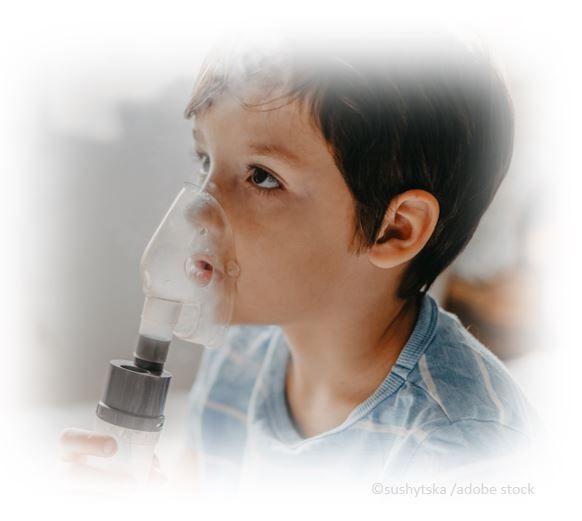- Clinical Technology
- Adult Immunization
- Hepatology
- Pediatric Immunization
- Screening
- Psychiatry
- Allergy
- Women's Health
- Cardiology
- Pediatrics
- Dermatology
- Endocrinology
- Pain Management
- Gastroenterology
- Infectious Disease
- Obesity Medicine
- Rheumatology
- Nephrology
- Neurology
- Pulmonology
Simple Primary Care Screening Tool Predicts Asthma Diagnosis in Preschoolers
The noninvasive, easily administered tool was able to predict at age 3 years children who would be diagnosed with asthma at age 5 years.

A symptom-based screening tool used in primary care practice accurately identified children at high risk of asthma at as early as 3 years of age, according to findings published online in JAMA Network Open.
Earlier identification of these vulnerable children could promote active disease monitoring, symptom control, and treatment interventions, as well as potentially reduce use of costly healthcare services, write study authors from Canada and Australia.
As context for their research the authors note that wheezing, a primary defining trait of asthma, is common in early childhood, reported in up to 50% of all children. However, use of wheeze to diagnose childhood asthma is controversial, given that in approximately half of preschoolers who experience the symptom it will disappear by the time they are of school age. Nonetheless, early persistence of wheezing symptoms, regardless of remission, has been associated with reduced lung function and chronic lung disease.
Use of current asthma prediction tools in primary care is limited, the researchers explain, as many require invasive tests, such as blood or allergy skin prick tests. Other tools have been developed based on populations of children predisposed to asthma or have not been validated in general populations.
Use of current asthma prediction tools in primary care is limited as many require invasive tests, such as blood or allergy skin prick tests. Other tools have been developed based on populations of children predisposed to asthma or have not been validated in general populations.
"...novel, pragmatic, and inexpensive screening tools that allow for the earlier identification of children at high risk of asthma are needed as a first step in busy primary practices,” the researchers say.
The original data used to develop their tool, the CHILDhood Asthma Risk Tool (CHART), came from the Canadian CHILD Study, with the goal to develop a symptom-based screening tool able to identify children at age 3 years who are at high risk for asthma, persistent wheeze, and health care burden at age 5 years.
The CHILD study (January 1, 2008, and December 31, 2012) comprised offspring of 3224 women who answered regular child health questionnaires until a child reached age 5 years; children attended clinic visits at ages 1, 3, and 5 years.
CHART identified factors associated with asthma in patients at 3 years of age (timing and number of wheeze or cough episodes, use of asthma medications including corticosteroids and inhaled bronchodilators, and emergency department visits or hospitalizations for asthma or wheeze) to identify children with asthma or persistent symptoms at 5 years of age.
Within the CHILD Study cohort, CHART was evaluated against specialist clinician diagnosis and against the modified Asthma Predictive Index (mAPI).
External validation of CHART was performed against 2 specific cohorts: the Australian general population health study, Raine, (n = 2185) at age 5 years and the Canadian Asthma Primary Prevention Study (CAPPS) (n = 349), a group of high-risk children, at age 7 years.
FINDINGS
Among 2511 children in the CHILD study with sufficient questionnaire data to apply CHART at 3 years of age, 2354 (93.7%) had available outcome data at 5 years. Mean age of the cohort at the 3-year clinic visit was 3.08 years and the group was 52.7% boys.
In the CHILD group at 3 years of age, CHART performed better than clinician assessments and the mAPI in predicting persistent wheeze (area under the receiver operating characteristic curve [AUROC]), 0.94; 95% CI, 0.90-0.97), asthma diagnosis (AUROC, 0.73; 95% CI, 0.69-0.77), and health care use (ED visits or hospitalization for wheeze or asthma) (AUROC, 0.70; 95% CI, 0.61-0.78).
Of particular note, the authors say, CHART provided the highest predictive capacity for subsequent health care use at 5 years of age, identifying 20% more children with ED visits or hospitalizations than the mAPI (sensitivity, 45.5% vs 25.0%) and approximately 10% more than the in-study physician (sensitivity, 36.4%) and external physician diagnosis (34.4%).
Of particular note, the authors say, CHART provided the highest predictive capacity for subsequent health care use at 5 years of age, identifying 20% more children with ED visits or hospitalizations than the mAPI (sensitivity, 45.5% vs 25.0%) and approximately 10% more than the in-study physician (sensitivity, 36.4%) and external physician diagnosis (34.4%).
The CHART predictive performance for persistent wheeze was similar in the general population Raine study in children at 5 years of age and in the high-risk CAPPS population at 7 years of age.
CHART targets information that is easily gathered by health care professionals through interviews or parent-reported questionnaires in primary care or low-resource settings, the authors write, and allows identification of children at high risk for additional testing and those at moderate- or low-risk for regular monitoring.
The researchers noted, "CHART is designed as a pragmatic screening tool to help busy primary care clinicians identify the small proportion of children at high risk for persistent wheezing (7% in our population) among all children who report wheeze (42% at any time point)."
Once identified, children at a high risk of having persistent asthma should be further evaluated for both severity and endotype of asthma, the authors said.
“To our knowledge, this is the first study to develop a noninvasive tool for early detection of asthma and persistent wheeze in a general population that has subsequently been validated in general and high-risk cohorts,” they conclude.
Reference: Reyna ME, Dai R, Tran MM, et al. Development of a symptom-based tool for screening of children at high risk of preschool asthma. JAMA Netw Open. 2022;5:e2234714. doi:10.1001/jamanetworkopen.2022.34714
